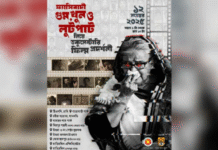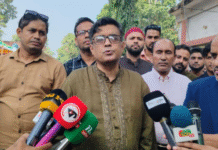Metro rail — the eager countdown
Shihab Sarkar | Financial Express November 09, 2019

A visit by this scribe to Kolkata in 1985 attained a special significance as the work on the city’s underground railway had been underway for over a year. Such an urban railway commuting infrastructure in Bangladesh capital at that time was a distant dream. The capital of India’s West Bengal state was then concentrating all its engineering and other related efforts on completion of its underground railway, popularly known as ‘Patal Rail’.
What struck the person from the neighbouring Bangladesh capital was the incredible level of patience of the Kolkata people; as well as the gesture of sincere cooperation towards the massive project. Kolkata was then a gridlock-plagued, unruly metropolis. Like in today’s Dhaka, reaching somewhere on time had long become a challenging proposition. Residents of the city were eagerly awaiting the underground railway’s completion as a great relief from their day-to-day ordeals.
People in Kolkata were seen undergoing lots of inconvenience in movement on foot and by automobiles. Unlike Dhaka’s elevated metro railway, Kolkata’s ‘Patal Rail’ required construction of long tunnels. As a result, piles of earth were seen lining the sides of the half dug tunnels, with transports and passersby moving along the muddy or dust-filled improvised roads. Few were seen grumbling, as the traffic police stringently enforced the laws of the vehicles’ movement. Few scenes of mess-up or anarchy could be encountered in the areas through which the sub-way would pass.
It was chiefly because the Kolkata residents were adequately made informed about the fruits of the ‘Patal Rail’ and what their temporary inconveniences would result in finally. In 2019, the Kolkata people move about the city with little hassle. They can keep their appointments without agonising worries during the short travels. A spectacular feature of the underground rail commuting in Kolkata is the disciplined way the passengers get into the trains and disembark from them.
Hopefully, Dhaka’s overhead metro rail will watch a similar scene. Clumsy and emotionally charged behaviour on the part of non-seasoned passengers could occur at places. These hiccups will disappear with the commuters getting used to the new mode of transport.
But the point that galls the future metro passengers is the messy state of Dhaka’s traffic management and hurriedly changed vehicle routes at present. As has been feared, the traffic movement in the already chaotic city is fast turning into seemingly unmanageable deadlocks. Over the last one year, a number of critical intersections have virtually emerged as literally dreadful points. Law enforcers, apparently, have no way out except following the strategies of emergency re-rerouting of all kinds of transport. They include big and small buses, cars, and different kinds of other automobiles — and non-motorised vehicles.
To cite instances, moving along the stretch from the Press Club point to the Paltan area has already turned a nightmare. In fact, the whole Paltan at rush hours, especially in the evening, nowadays turns into an area filled with death traps. Speeding heavy buses, vans, smaller non-motorised vehicles, often defying traffic police signals, have turned the ‘junction’ into one of the most feared areas. Many feel extremely shaky while crossing the ‘road’, with high fences erected along the mid-road up to the Press Club main gate. Another such area is found at the Shahbagh point with its two stretches — one up to the Intercontinental Hotel, and another reaching the Doel Chattar. The original roads in these areas have shrunken by more than half to make space for erection of viaduct pillars for rail tracks and the stations.
There are prerequisites for putting a metro rail in place. But unlike the sprawling and British planned Kolkata, Dhaka is constrained by space limitations. Against this backdrop, the metro work ought to advance in such a way that it doesn’t start annoying the future commuters at the very construction stage.









